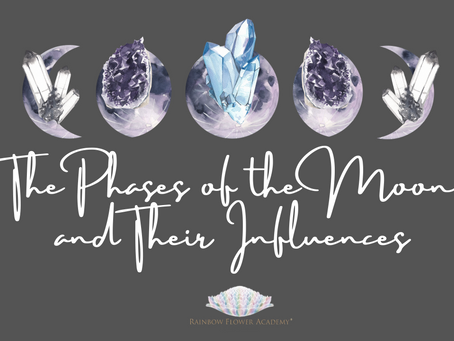In January, at the Lemuria workshops, we were instructed by Kryon and the Star Mothers to learn more about the Moon, because anchoring the Divine Love that comes from the Divine Feminine in all forms of Life and understanding about the 28-day cycle and 13 moons, and even more about the Moon, are key to balancing the Earth. I started researching because I wanted an article about the 8 lunations, which many of us are not familiar with yet, and found this wonderful publication from Astrolink.
Have fun with a cup of tea and love from God, with Love,
Luciana
The satellite of our short term cycles

Ah, the mysterious and inspiring Moon… or Luna, Selene, Isis, Artemis. There are many names and mythologies surrounding this celestial body, which has a very close relationship with our planet, with mankind, and with nature. In the physical
In the physical world, gravity, tides, and the dynamics of body fluids are direct examples of its action.
In our personal realm, its phases set the tone when allied with astrology to carry purposes and peculiar energies, which influence us daily in several areas such as our emotions, fertility aspects, nutrition, in the process of interacting with the public, in our business, interpersonal relationships, health, sleep, among other things.
Due to its gravitational force, the Moon interacts with the volume and dynamics of all the liquids present on our planet, and this includes the plants, the animals, and the human body itself. Our blood flow and lymphatic fluid can also suffer its influence; we cannot forget that our bodies are composed of 70% water.
An important point to consider is the lunar phases. While the Full Moon reflects the most sunlight possible, the New Moon reflects the least. In between the two, other phases emanate this energy to different levels. In a little less than a month the Moon goes through 8 phases, completing its cycle. We can even say that each night the Moon channels and reflects a different energy from the Sun, which is why it is important to determine what phase the Moon is in.
Embark on this journey towards understanding all the potential that the lunar dynamics can provide.
Lunations: the Moon in its cyclical realms
The Moon is the fastest moving star in our solar system, taking on average 28 days to go around our planet completely, changing its main phase every 7 days. Every month it also passes through the 12 signs of the zodiac, staying on average 2 days in each and forming various aspects with other stars. In fact, it takes 28 and a half days for the cycle to complete, from one New Moon to another New Moon, moving about 1 degree every 2 hours.
With this, it can be said that this much worshiped and revered star throughout human existence plays an important role in our short-lived cycles, our emotional fluctuations, and the ups and downs of our mundane lives, creating a personal dynamic monthly, weekly, daily, and even hourly. Each phase of the Moon can be interpreted in one way, and its total set forms a mosaic of our lives at any given time.
Each month, the New Moon is the potential for a new beginning, and the Full Moon is a culmination. Since the Moon’s orbit takes an average of 28 days (and not 30 or 31), every two or three years we have an adjustment, with a second Full Moon in a month, called the Blue Moon.
The lunar month then begins at the New Moon, which is when the Moon and Sun are in conjunction. Each lunar month brings two opposite houses as it passes through your birth chart. Depending on the size of the houses in your birth chart, if there are intersecting signs, this cycle can be altered so that sometimes the Full Moon can fall in the house next to the house it was opposite in the New Moon. For example, there may have been a New Moon in the 5th house of your chart, but a Full Moon in the 10th house instead of the 11th, for example.
Walking between Phases
Think of a project, for example, that has its beginning, development, mishaps, until its conclusion and results. The New Moon is the initial phase, where there are ideas, plans, drawings, where something emerges, and the Full Moon is the results.
The First Quarter phase has the role of protecting and leveraging what is in progress, and the Waning Quarter helps to close issues, so that a new cycle can begin. Knowing what each phase represents is essential in order for us to take advantage of its influence in the best way possible within the context of our lives.
New Moon and Full Moon are called Lunation. In astrology, lunations have the power to influence the issues in the astrological house where they occur in an astrological chart, indicating possibilities that can be realized or aspects that can be activated.
Obviously we must always keep in mind that, physically, the Moon does not “change” its shape. What does change is its relationship with the Sun. While the Sun takes 365 days to go through the 12 signs of the zodiac, the Moon does this in about 28 days. On the 29th day she conjuncts the Sun again, starting another New Moon.
This new lunation is given the energy and name of the sign where the New Moon began. For example, if it was in Scorpio, it will be the Lunation of Scorpio. After 28 days will come the Lunation of Sagittarius, Capricorn, and so on. In the 3 days before the Lunation, the lunar energy starts to grow, reaching its peak on the exact day of the Lunation.
The 8 Phases of a perpetual rhythm
Many people know only the 4 main phases of the Moon, also called active phases, especially here in Brazil: New Moon, First Quarter, Full Moon, and Waning Quarter. However, the Moon has 4 more intermediate phases, treated as receptive: the Crescent Moon, the Gibbous Moon, the Disseminating Moon, and the Waning Moon – the latter with its final 3 days called the “Black Moon”, the end of the phase that precedes the next New Moon.
Examining each lunar phase can provide insight into the physical, emotional, and social unfolding that we undergo over the total cycle, and provide a guide for planning our lives.
1) NEW MOON – here the so-called high tide times happen, where the Sun and Moon are in conjunction, practically aligned. The gravitational attraction between the earth and moon is very high and they practically add up. Astrologically, it helps in the beginning of things, brings new beginnings, changes, and spontaneity. It is a good period for starting new projects, closing deals, or opening businesses. Everything that is started during the New Moon picks up a highly positive energy charge, which predicts success.
2) GROWING MOON – it is the intermediate phase between the New Moon and the Crescent Moon. It indicates a phase for gathering knowledge and beginning to shape our plans.
3) QUARTH GROUND – here the Moon and Sun are aligned at 90 degrees, forming a square. The Moon’s gravitation opposes that of the Sun, although they do not annul each other, something that generates the so-called minimum tides. Astrologically, it helps expansion, but also gives rise to confrontation of problems and unresolved issues. Here is the time to resolve issues and make decisions. Plans in progress may be hindered. It is also a good period to create foundations for your plans and to continue taking care of what you have already started, even if it requires a little more effort. Everything generated here tends to grow and prosper. The car should keep up and accelerate, increasing gears so you don’t give up on the way up the hill.
4) GIBBON MOON – it is the intermediate phase between the Crescent and Full Moon. It is a phase for fine adjustments, where our goals become more visible, although it is necessary to stop and analyze what is working and what is not in order to make the necessary adjustments and filters for completion. Let go of everything that doesn’t work to refine the process.
5) FULL MOON – about two weeks after the beginning of the New Moon phase, there is a new alignment between the Moon and the Sun. Again, a high tide phase. It is the culmination of all the other phases, where everything that has been done and prepared can finally be harvested. If everything went well during the process, you will harvest good fruits. It is a period of fulfillment, revelation, and helps in the perspective of things. During the Full Moon, we may also feel more desirous of a relationship and long for a mate, although major crises also usually occur during this phase. Those who are more predisposed to insomnia can suffer more during this period, which is also not very suitable for undergoing surgery in general.
6) DISSEMINATING MOON – it is the intermediate phase between the Full and Waning Moon. In this phase, a greater understanding between people allows knowledge and emotions to be shared. A great time to dive inside yourself and find yourself, as well as help others to do the same. It is a good time to reflect on the events of recent times and start preparing to resolve what is pending.
7) MINGUATING QUARTER MOON – here the gravitational influence between the Sun and Moon again diminishes. It helps with finalizations, and is a good period to resolve unfinished business or finish unfinished projects. In any case, you should leave behind what has passed and start planning for the future. It becomes easier to end relationships and get out of our feelings during this phase. This phase is also indicated for surgeries in general.
8) WALING MOON – it is the intermediate phase between the Waning Moon and the New Moon. Here is the time to stop for a while to relax, reflect, and evaluate. Don’t mess with what you have finished, and don’t effectively start new processes. Free yourself from the past to start a new cycle that is coming, without ties or fears. Make considerations and glimpse the possibilities of the next lunation, to plant a new seed, even if it will be a new seedling from the same plant.
Everything has its phases and rhythm
The teachings of Hermes Trismegistus tell us in his fifth law that everything has its rhythm, everything has its ebb and flow – everything rises and falls. Think of the cycles of a plant, for example, from its initial conception.
Making an analogy with the Moon, in this case, the first phase of sowing, would be like the New Moon, a period that relates to the seed that is in the ground, preparing for germination. A new beginning has been established.
In the first steps of the Crescent phase, it is as if the bud that has been planted is drawn out of the Earth by the initial impulses of light. During the remaining stages of this phase, it is as if the plant goes through a strengthening process, mobilizing its energies against the elements of nature.
When the Fourth Crescent phase arrives, it is as if the plant has already passed through the initial stages of survival and is now taking root. By firmly anchoring its life force, the plant is able to focus its energies on growing stems and leaves with the tiny buds, which appear at the beginning of the Gibbous phase.
During the Gibosa phase, our plant is focused on the reason for its existence. By ridding itself of all that is superfluous, the time finally comes for its fulfillment by blossoming into a flower. The Full Moon Phase would be the completion, the culmination of the process. The work has been done and the gardener can rest, enjoy and evaluate his efforts. As the Full Moon progresses through its forty-five degrees, the flower becomes the fruit.
The Disseminating Moon is where we harvest what has been planted. The goal of the plant is now to give back to the earth, to the one who created and planted it, all that it possesses, nourishing others.
When the Waning Moon approaches, the harvest is over, the abundance has been shared, and what is left in the fields begins to decay… The cycle is ending.
During the Balsamic phase, the seeds are buried back underground. What was planted before no longer exists in its original form. This is the time of transition.
The Moon’s light is already very dim, and at the end of this phase it will disappear into darkness, into a last, small 3 day phase called the Dark Moon, the final charge to restart the whole process again with a New New Moon.
The Moon and its domains
In fact, the Moon has a great influence in regulating any cyclical process, any activity, situation, behavior or habit that has a well-defined beginning, that develops, that achieves results, and then begins to diminish and finishes. It is like a breathing movement, in which we breathe in and out towards our vital gaseous maintenance. Other examples are the act of gaining and losing weight, spending and saving, basic habits such as growing and cutting hair and hair, maintaining fingernails, etc. As a representative of the feminine principle, emotions, sensitivity, intuition, gestation, fertility, and nutrition, it has good influence on these and other matters, such as:
– It inspires a more fluid or more difficult emotional exchange between people;
– It acts on our emotional dynamics, influencing our tempers and moods, making people more receptive and cheerful, or sad and melancholic, depending on the phase;
– The phases of the moon are also linked to greater or lesser emotional neediness;
– It rules over the feminine capacity for gestation, fecundation, nourishment, and protection. Research shows that during the changes of the Moon’s phases, the incidence of effected births increases, especially during the Full Moon;
– It interacts with our appetite and metabolism, as well as in the assimilation of nutrients and liquids. Therefore, it also acts on the processes of weight gain or loss;
– It alters our perception and desire for a specific type of food or flavor;
– It affects the tides and the fluids of plants and animals, including our blood and lymph flow;
– It interferes with the quality of our sleep and dreams, influencing quiet or restless nights;
– Good aspects between the Moon and Neptune influence the quality of our sleep. Bad aspects between the Moon and Uranus can cause insomnia;
– Good aspects between the Moon and Saturn are great for real estate transactions or home repairs. Good aspects between the Moon and Pluto are good for disposing of useless things;
– The Moon and Neptune in tension can also cause lack of concentration and low productivity. The Moon and Mercury in tension can lead to an accumulation of tasks or inconclusive work;
– The Moon also interacts with humidity, influencing promising moments for drying;
– It acts on the durability of vegetables, fruits, and legumes, influencing their preservation or the speed of rotting;
– It can also interact with rainfall. The famous lunar halo, that yellowish disc we see from time to time around the moon, is usually associated with the proximity of rain;
– It influences people to attend more or less social events and fill up places like bars, shopping malls, concerts, and restaurants;
– The opposite is also true, the moon can generate laziness and withdrawal, while places may be emptier at certain times;
– It can decrease or increase swelling, edema, bleeding, or interfere with the quality of a post-operative period;
– Commerce and other activities that depend on the presence of or interaction with the general public can feel the Moon’s influence a lot;
– Good aspects between the Moon and Venus are very favorable for encounters, romances, and unions;
– According to the sign the Moon is in, there is a greater or lesser predisposition to romantic encounters, sexual desires, or closeness in general;
– And finally… It makes our nights more beautiful and illuminated!












